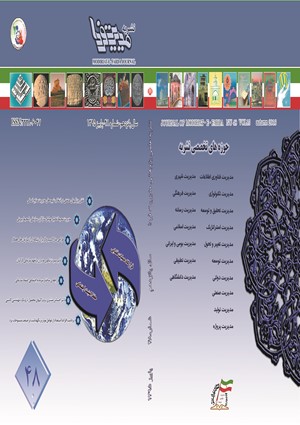شناسایی و رتبه¬بندی ابعاد و مولفه¬های نقش ذینفعان آموزشی در استقرار مدیریت دانش (مطالعه موردی: آموزش و پرورش استان مازندران)
محورهای موضوعی : مدیریت دانش
1 - دانشگاه آزاد اسلامی واحد ساری
2 - دانشگاه آزاد اسلامی واحد ساری
کلید واژه: استقرار مدیریت دانش ذینفعان آموزشی,
چکیده مقاله :
امروزه مديريت دانايي مقوله اي مهم تر از خود دانايي محسوب مي شود که در سازمان ها به دنبال آن است تا نحوه چگونگي تبديل اطلاعات و دانسته هاي فردي و سازماني را به دانش و مهارت هاي فردي و گروهي تبيين و روشن نمايد. مدیریت دانش به منظور آن که بتواند اثر بخش باشد، نیاز به حمایت و مشارکت ذی نفعان دارد. اگر زمینه مشارکت در پروژه های مدیریت دانش فراهم نباشد، موفقیت چشمگیری حاصل نخواهد شد؛ چرا که عامل اصلی همان ایفای نقش موثر و سازنده ذی نفعان است که به عنوان یک عامل تسهیل کننده در اجرای برنامه های مدیریت دانش عمل نمایند. لذا یکی از ضروری ترین ملاحظات در استقرار صحیح مدیریت دانش، تعیین ابعاد نقش آفرینی ذی نفعان می باشد. این تحقیق با هدف شناسایی و رتبه بندی ابعاد و مولفه های نقش ذینفعان آموزشی در استقرار مدیریت دانش در آموزش و پرورش انجام شده است. روش پژوهش، توصیفی از نوع پیمایشی است. جهت گردآوری داده ها از پرسش نامه محقق ساخته ذینفعان آموزشی استفاده شد که روایی آنها به تایید متخصصان رسید و پایایی آن با استفاده از آزمون ضریب آلفای کرونباخ 91/0 محاسبه شد. نتایج آزمون تحلیل عاملی تاییدی نشان داد که: متغیر نقش ذینفعان آموزشی دارای سه بعد "فردی"، "سازمانی" و "فرآیندی" و نوزده مولفه (انگیزه شخصی، آگاهی، مهارت، تجربه، تمایل، مشارکت جویی، آموزش پذیری، فرهنگ سازمانی، ساختار سازمانی، فناوری سازمان، منابع انسانی، مدیریت و رهبری، محیط سازمان، ایجاد فرآیند دانش محور، فراهم آوردن زیر ساخت های فنی، فرآیند خلق دانش، فرآیند کسب دانش، فرآیند تبدیل دانش، فرآیند بکارگیری دانش) است. همچنین در بین ابعاد نقش ذی نفعان آموزشی، بعد فردی دارای بیش ترین تأثیر و بعد فرآیندی دارای کم ترین تأثیر است و مدل ارایه شده دارای برازش مناسب می باشد.
The purpose of this study was to identify and rank the dimensions and components of educational stakeholders' role on implementation of knowledge management in Mazandaran Education System. The research was applied and descriptive. According to Cochran formula, 336 participants were randomly selected as a sample from 2653 heads of education offices, their assistants, experts and schools' managers in Mazandaran. The measurement tools are the researcher-made questionnaire of educational stakeholders. The content validity of the questionnaire was confirmed by the experts. Cronbach' calculated alpha for the questionnaire was 0.91 and the reliability of the questionnaire was confirmed. The research findings showed that there are nineteen components in three dimensions (individual, organizational and procedural) for educational stakeholders on implementation of knowledge management. Moreover, there is a positive correlation and relation between the role of educational stakeholders and three dimensions. Also, individual dimension is the most effective and procedural dimension is the least effective one among all three dimensions. Finally, suitability indicators showed the accepted model with data and the whole model was confirmed. The results showed that the authorities of education system can use this model to implement knowledge management through vast and effective cooperation of educational stakeholders and increase the educational quality and organizational productivity.
Balogun, O., Hawisa, H., & Tannock, J. (2004). Knowledge Management for Manufacturing: The Product and Process Database. Journal of Manufacturing Technology Management, 25(7), 245-260. Cong, X.M., & Pandya, K. (2003). Issues of Knowledge Management in the Public Sector. Electronic Journal of Knowledge Management, 1(2), 25-33. Davenport, T.H., & Prusak, L. (2000). Working Knowledge: How Organizations Manage What They Know. Boston, Massachusset, Harvard Business School Press. Degler, D., & Battle, L. (2000). Knowledge Management in Pursuit of Performance: the Challenge of Context. Performance Improvement, 39(6).
García-Álvarez, M.A. (2015). Analysis of the effects of ICTs in knowledge management and innovation: The case of Zara Group. Computers in Human Behavior, 51, 994-1002.
Kanapeckiene, L., Kaklauskas, A., & Zavadskas, E.K. (2010) Integrated Knowledge Management Model and System for Construction Projects. Engineering Applications of Artificial Intelligence, 23(7), 1200 – 1215.
Li, P. (2001). Design of Performance Measurement Systems: A Stakeholder Analysis Framework, The Academy of Management Review. Mississippi State, April. Lindler, F., &Wald, A. (2010). Success factors of knowledge management in temporary organizations. International Journal of Project Management, 29(7), 877-888. Mohayidin, M., et al. (2007). The application of knowledge management in enhancing the performance of Malaysian Universities. Electronic Journal of Knowledge Management, 5 (3), 301 – 312. Rodriguez, A., Millan, A.L., Jose Luis Roldan-Salgueiro & Jaime Ortega-Gutierrez. (2013). Knowledge Management and the Effectiveness of Innovation Outcomes: The Role of Cultural Barriers. The Electronic Journal of Knowledge Management, 11(1), 62-71. Terzieva, M. (2014). Project Knowledge Management: How Organizations Learn from Experience. ELSEVIER, Procedia Technology, 16, 1086-1095.
Watson, S. L., & Reigeluth, C. M. (2008). Community members’ perception on social, cultural changes and its implication for educational transformation in a small school district community. Journal of Organizational Transformation and Social Changes, 5(1), 45-65.
Yang, L.R., Chen, J.H., & Wang, H.W. (2012). Assessing impacts of information technology on project success through knowledge management practice. Automation in Construction, 22, 182–191.


